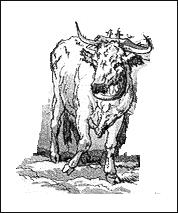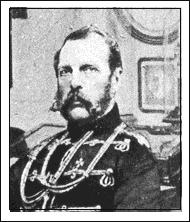Emancipation of the Russian Serfs
German-Russian Parables
I wish I could remember all the parables my grandfather Ludwig Hein and others told me. Here are just a few:

A Russian Ox & His Liberation
by
As Remembered by Judy A. Remmick-Hubert
A government man came to the old ox and said, the Tsar has proclaimed you shall have land, a plow and a yoke plus a few bags of seeds.
The old ox never wanted to feel the yoke, again, so he stomped on the yoke. Without a yoke he could not plow.... But he never wanted to plow anyone's field even if the government said it was his... When he grew quite hungry, he ate the seed.
The ox lost his land in a card game in which he had hoped to win money so he could buy hay.
One day the man whom the ox had known as master came upon the ox who was thin, dirty and miserable. "I can't pay you money but you could work for your food? And you can stay in the barn at night," told the ex-master who's clothes were no longer new but they were patched with care and small fine stitches.
The ox knew he had no choice because he wanted to live another day. So, he walked back to the barn with his head held low and several feet behind his ex-master, who was to be called, "Boss."
In the morning, he tasted the sweet hay, and, soon he felt the yoke upon his shoulders. It was something he knew and understood. This was better than starving, the ox concluded because he wanted to stay alive even if it meant he was a landless peasant working for his ex-master.
The ex-master began to prosper, again. He bought the ox a wife with four healthy and strong step sons...
The ox appeared happy and content and when he was asked if he prefer freedom or working for the ex-master, the ox replied, "Fate has given me a kind and generous ex-master who has promised to care for me and my family when I'm gone, and, he has promised me a spot in the graveyard. That is all I need."
Was this reply because the ox was stupid as most ox are said to be?
The End
And, what is the moral of the story?
Send me your thoughts: Remmick@aol.com

Tsar Alexander II, House of Romanov
Tzar Alexander II's "The Emancipation Manifesto" [liberation of the serfs] was published in March of 1861. In the memoirs of General Cherbachev he wrote: "...No pen could describe the rapture of the people as the Czar rode past.. I am happy to have witnessed such a moment..." This was short lived. The serfs did not realize that when a man was set free, he was set free to "pay his own taxes", "to make annual payments to redeem the land", "to feed ones own family", and, lastly, "to pay for ones own burial". Freedom came at a price.
Lacking the education and experience of a "free man", the majority of the ex-serfs mismanaged their own affairs and became more improverished then they had been as serfs. Sullen discenchanted ex-serfs rebelled against the "clerks whom they believed were robbing them bind and the government officials who were just as greedy and had their own reasons to suppress the common peasant". Riots occurred in many parts of Russia.
Unable to understand the reaction of the ex-serfs, Alexander II believed these riotous ex-serfs were "ungratefully sons-of-devils" and he called for immediate order and obidence.
The yoke of suppression comes in many names and forms.
Order was restored and the ex-serfs sank into new lows and there hovels became breeding places for the future evolutionists.
Czar Alexander II is blamed for everything that went wrong in the lives of all, especially the ex-serfs, living in Russia and is blown apart by a bomb in 1881.
The broad brushes of the future Bolshevik [communists] historians are not kind to Czar Alexander II and one must be very careful in separating actual history and progaanda.
(1) He liberated the serfs from being slaves to their masters in 1861..
Note: If others , Grand Dukes on down to the local government officials, would have worked to have improved Russia instead of worried about their own pocket it would have benefited all if given some time...
(2) He abolished corporal punishment....
(3) Instituted public trials before juries and approved the reconstruction of the judiciary...
(4) Established the right of an enlisted man to rise in the military to an officer and be able to rise through the ranks
(5) Introduced Education Act in 1863
(6) Created the Zemstva which gave the country local self-government
(7) Thousand of new railroads were laid
(8) Permission of private banks was given
(others).....
(Last Manifesto) He had set up a limited form of a representative [regardless of class or financial considerations] government at the national level....
Note: Here, again, if his heir Alexander III had better understood this dream of his father's he would have taken up his father's last manifesto which declared these first steps toward a parliamentary government and he would have taken a different road that may have lead all Russians in the opposite direction of the road he did take which carried the Russians into revolution and senseless blood shed of millions and millions.....
[JARH-T Note:The gentleman prefers his name not to be used. He sent the following to me because he felt the parable the Russian Ox was not accurate. And, the following was to inform me of the facts. I did find his information provided important facts and are of great historical value for all of us who are interesting in truth and not fiction..]
140 The Epoch of the Great Reforms
The draft "Regulations" worked out by the Editing Commissions were submitted to the Main Committee on Peasant Affairs, under the chairmanship of Grand Duke Constantine Nicholaevich, who replaced the original incumbent, the conservative Prince Orlov. Not without difficulty and pressure on individual members did the Grand Duke steer the draft of the Editing Commissions through the Main Committee, after which the draft was submitted to the consideration of the Council of State.
On January 28, 1861, the tsar himself chaired a general session of the Council of State and delivered a major speech reviewing the history of serfdom and the previous attempts to limit it. He then declared his "direct" and "unswerving" determination to abolish serfdom at once, concluding with the following charge to the Council: "I have a right to demand one thing from you: that you set aside all private interests and act not as landlords but as dignitaries of the state, entrusted with my confidence." The Council quickly examined the draft and finished its work in the middle of February. On the suggestion of Prince Gagarin, the Council included a supplementary article by which the peasants were given the option of receiving "gratuitous" allotments, one quarter of the maximum allotment in size, free of charge, if they so desired.
On February 19, the tsar signed the "Regulations" and issued a manifesto on the abolition of serfdom, which ended with these words: "Orthodox people, bless yourselves with the sign of the cross and call God's blessing upon your free labor, which will be the basis of your domestic welfare and the common weal." On March 5, the "will" enunciated by the tsar was proclaimed in the capitals and then the manifesto and the Regulations, printed in vast quantity, were distributed throughout Russia.
What was the first impact of the manifesto? As we might expect, the reaction was diverse and included dissatisfaction from both right and left. The landlords and advocates of serfdom were either indignant or at least disgruntled by the destruction of their "legitimate rights" and the expropriation of their "sacred property." The left, headed by Chernyshevsky at home and Herzen abroad, was disillusioned by the halfway nature of the reform and even denied that serfdom had been abolished. The peasant folk themselves generally received the Regulations of February 19 peacefully and could not but feel the amelioration of their lot in escaping from the landlord's rod. All the same, there was disillusionment and puzzlement in some places and others even experienced agitation and disorders. This reaction was entirely natural in view of the magnitude and complexity of
The Terms of the Serf Reform 141
the regulations, which were incomprehensible not only to the illiterate peasants but also to many of the zealous local administrators, who were accustomed to shout and shake their fists but were now entirely unable to understand and interpret the new laws. And yet these men were supposed to untangle the complex, centuries-old web of serf relations.
The peasants were naturally dissatisfied with the terms of the regulations that submitted them to a transitional period of two years of continued bondage and to the future status of "temporary obligation," which could last up to twenty years, pending the conclusion of negotiations between peasant and landlord. It is understandable that the peasants awaited "some other will [edict]," which they thought the tsar had meant to grant them, but which the landlords and bureaucrats had concealed from them. In the first months after the publication of the regulations agitation and disorders occurred in many places, resulting in "pacification" measures, which were especially bloody in the village of Bezdna in Kazan province. In this case, troops fired into an unarmed crowd of peasants, killing several dozen and wounding over one hundred. Responsibility for the use of force lay partly with high-ranking military emissaries whom the tsar sent into each province to assist the local authorities in maintaining order at a supposedly dangerous moment. Moreover, some landlords and bureaucrats saw "mutiny" in every crowd of noisy peasants and each refusal to perform barshchina, and their exaggerated reports sometimes led to "pacification" by the lash, or occasionally by cold steel or firearms. But nowhere were there attacks on troops or police or lynching of landlords. Where there were intelligent and calm administrators, "mutinies" and repressions did not occur; in Yaroslavl province, for example, General M. L. Dubel't "pacified" all mutinies by personally talking with the mutineers.9
The Terms of the Serf Reform
According to the first article of the lengthy "General Regulations on Peasants Emerging from Bondaäe," "The enserfment of peasants settled on landlords' estates and of domestic servants is abolished forever," and the former serfs "are granted by right the status of free rural inhabitants, personally and with respect to property." Beyond this basic guarantee of freedom the regulations contain a multitude of qualifications and complexities.
9 Russkaia Starina (1891), vol. II, pp. 469174.
142 The Epoch of the Great Reforms
In the first place, the regulations established a transitional period of at least two years in which the peasants would remain "temporarily obligated," rendering a fixed obrok or barshchina to the landlord. In the first two years the landlord and peasants, with the help of an arbitrator if necessary, were to draw up so-called "statutory charters," which would record precisely the land allotments awarded to the peasant communes. Subsequently, a separate agreement regarding the compensation to be paid for them was to be concluded. Upon the conclusion of these agreements the peasants were to attain the legal status of "peasant property owners" and all obligatory ties to the landlord would cease.
Regulations on the size of peasant land allotments were complex because they attempted to take into consideration the variations in regional agrarian conditions. Three basic zones-blacksoil, nonblacksoil, and steppe-were recognized, and each was subdivided into districts, for which the regulations set maximum and minimum land allotments per soul. These varied widely; for example, in various districts of the blacksoil zone the maximum ranged from 7.4 acres per soul to 16.2 acres; the nonblacksoil zone ranged from 8.1 acres to 18.9 acres; and the steppe ranged from 8.1 to 32.4 acres. Since the minimum allotment in each case was one third of the maximum, it was possible for some peasants to receive as little as 2.5 acres per soul, or even 1.8 acres if they chose to receive a "gratuitous" allotment of one quarter of the maximum-a striking contrast to the possible upper limit in some steppe districts. It has been calculated that in practice the average allotment per soul for the country as a whole turned out to be 8.9 acres, since 10,050,000 souls received 91,800,000 acres of land, including 500,000 who received the inadequate gratuitous allotment.
The question of peasant landownership was complicated by communal possession and redemption payments. Except in certain western provinces, land was transferred from the nobility not to individual peasants or to households but to communes, which equalized the distribution of the land and jointly utilized common pastures and woodlots. Theoretically, individual members of the commune might demand their share of the land, providing they paid for it, and communes might distribute all of their land as the private property of the members if a two-thirds majority so decided. But those options were rarely applied in practice. Compensation of the landlords for the peasant allotments was also a communal affair. Since the peasants lacked the capital to pay for the land outright, the state offered to advance the landlord up to 80 percent of the purchase price in interest
The Terms of the Serf Reform 143
bearing bonds. Once this was done the repayment of the government advance was guaranteed collectively by the peasant commune. Their debt to the state was funded for a forty-nine-year period, and it was the communal responsibility to keep up the annual service to this debt by apportioning each household its share of the payments. Clearly this arrangement gave the commune a powerful motive to retain its redemption-paying members, thus inhibiting the mobility of the individual peasant despite his emancipation from direct obligations to the landowner.
The statutory charters regulating the size of peasant allotments and compensation for the landlord formed an exceedingly complicated and variable system. In the exceptional case that the landowner and the peasants wished to negotiate a voluntary redemption, agreement without a financial advance from the state, the price was not fixed by law. And, as previously noted, the peasants might avoid any redemption if they wished to obtain a gratuitous allotment, running the risk of becoming tenant farmers or wage laborers because of the inadequate size of these land allotments. But in most cases the price of the land was officially regulated by a rate-schedue that was supposed to reflect the value of the land, in keeping with the rule that peasants should redeem their land and not their persons. In practice, however, the rate-schedule worked quite favorably for the landowner. In the first place, the rates were calculated on the basis of the obrok ayments that were in force at the time, capitalized at 6 percent, and :,he resulting price exceeded the actual market value of the land. This was markedly the case in the nonblacksoil regions, in which the nobility valued serf labor more than the poor land. Moreover, the rate per acre set by the schedule often was not directly proportional to the number of acres received by the peasant. In many areas the rate-schedule was higher per acre if the peasants did not accept a full; allotment; sometimes the price per acre for a minimum allotment was double the price per acre for a maximum allotment. Finally, various articles in the regulation permitted the landowning nobility in many districts to keep woodlots and other valuable pieces of ,property on which the village economy depended. These parcels of :`land were popularly known as "cutoffs" (otrezki), and were galling to ;the peasants, who often had been accustomed to the use of this land before emancipation. From all of this the peasant often gained the impression that he was really redeeming his person after all, and that t the nobility ended up with land that belonged to the peasant by right.
End







